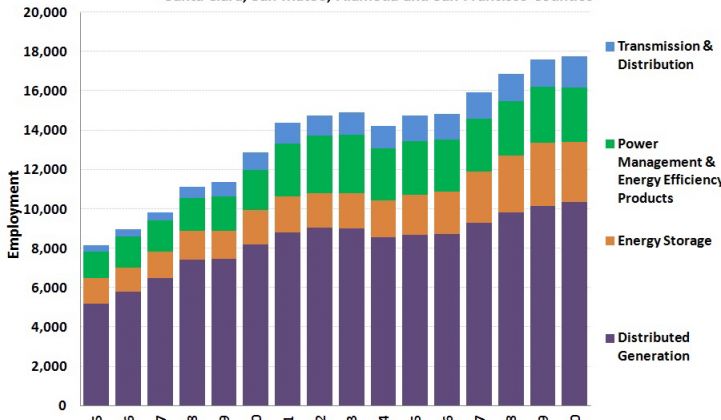Green technology means job growth for Silicon Valley, whether we’re talking about smart grid, solar, energy storage or some form of IT that supports the green industries named above.
So says a new report that pegs the Valley’s 2010 “smart grid-related” job count at nearly 17,800, up from 12,560 in 2009 and more than double the number of jobs back in 1995. That growth includes a five-percent increase during the 2008-2010 recession, when California total employment fell nearly eight percent.
All in all, it’s a good statistic to bolster the Valley’s claim as the center of greentech innovation and investment — even if some regions, like North Carolina’s Research Triangle, might be nipping at its heels in terms of specialties like smart grid.
The Silicon Valley Leadership Group, which sponsored the study along with Pacific Gas & Electric and the city of San Jose, will be presenting the new jobs report this Friday morning at its 12th annual Energy Summit in Mountain View, Calif.. (Shameless self-promotion — I will be moderating the 10:45 a.m. panel in which Doug Henton, CEO of Collaborative Economics, will present the report. Also speaking will be Matt LeCar of General Electric, Varun Nagaraj of Echelon and Peter Yeung of Silver Spring Networks.)
The report included Santa Clara, San Mateo, Alameda and San Francisco counties, and as with last year’s inaugural report, it comes with a few caveats. First of all, despite its title, “Smart Grid Deployment and the Impact on Silicon Valley,” more than half of the jobs counted in its total — some 58 percent of them — are in the category of distributed generation.
That would include solar manufacturing powerhouses like SunPower (now owned by French oil giant Total) and startups such as Miasole and Nanosolar, as well as solar inverter companies and installation and financing startups such as SolarCity and SunRun. In fact, given that the report tallies up 2010 jobs, it would also include jobs at now-defunct solar company Solyndra.
Another 17 percent, about 3,100 jobs, were in energy storage, which includes batteries for electric vehicles as well as grid applications, as well as fuel cells from companies such as Bloom Energy, which just raised $150 million more from venture investors. Nearly as many jobs, 2,800 or 16 percent of the total, fell into the “power management and energy efficiency products” category, which covers everything from smart lighting systems and appliances to power electronics and semiconductors.
That leaves only 1,600 jobs, or 9 percent of the total, in the transmission and distribution category, which might be most closely classified as “smart grid.” That would include big grid players like Silver Spring Networks, Trilliant, Echelon, and others, as well as companies in the space that have since been acquired, such as eMeter (bought by Siemens) and Tropos Networks (bought by ABB), to name two prominent examples.
It’s also important to place the impressive jobs growth across all these green sectors against Silicon Valley’s core high-tech jobs engines. Software accounted for nearly 120,000 jobs in the four-county region in 2010, semiconductor and equipment manufacturing employed nearly 49,000, and computer hardware accounted for 38,500 jobs. Other key job sectors, such as electronic components manufacturing, communications services and equipment manufacturing and IT wholesale trade, all employed more people in Silicon Valley than did all of the green jobs in the region.



